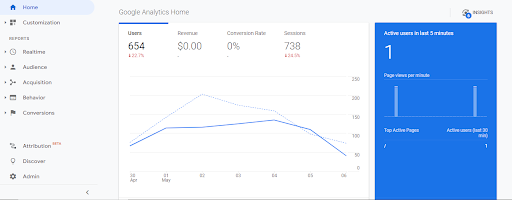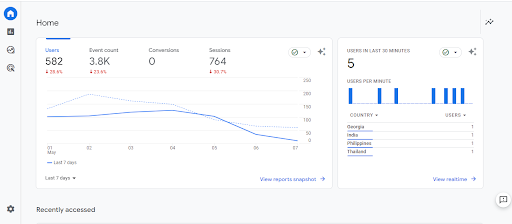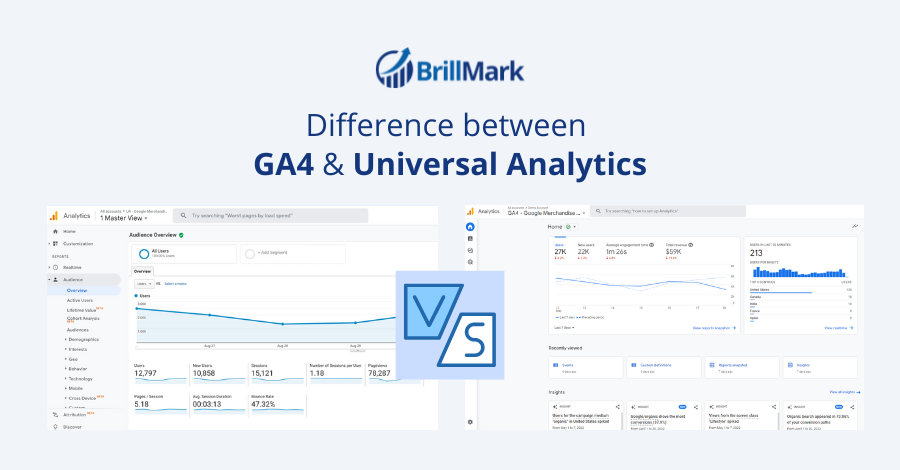The worlds of digital analytics is undergoing a significant transformation in 2023, with Google Analytics 4 (GA4) taking center stage and replacing Universal Analytics (UA or GA3) as the go-to tool for tracking website and mobile app performance.

Although this Universal analytics to GA4 transition may seem intimidating, it presents an exciting opportunity for businesses and website owners to leverage the latest features and capabilities of GA4 to gain deeper insights into user behavior and enhance their digital marketing strategies.
To make the GA4 migration seamless, Google has provided a comprehensive guide with detailed installation instructions, tips, and best practices for maximizing the potential of this powerful tool.
However, it’s important to remember that comparing metrics between UA and GA4 has limitations.
By embracing GA4’s cutting-edge capabilities, companies can stay ahead of the curve and unlock new opportunities for growth and success in the digital world.
However this transition may be difficult for you as if one wrong step and all the previous data may be lost. We at Brillmark have been helping our clients transition to GA4 as every single data is important Business.
We at Brillmark have compiled a comprehensive guide with detailed installation instructions, tips, and best practices to facilitate a seamless transition.
Transitioning to GA4 is recommended for future-proofing your analytics strategy.
For expert guidance and a seamless transition, contact Brillmark. We’re here to assist you.
This article provides an overview of what metrics can and cannot be compared between Universal Analytics and Google Analytics 4. As you have migrate to GA4 from Universal Analytics by June, Brillmark is here to help you.
Difference between UA & GA4
Here are some notable distinctions to consider between GA4 and Universal Analytics:
A New Interface for Reporting
GA4 and Universal Analytics have different reporting interfaces.
UA Reporting Interface:
- UA’s reporting interface categorizes all reports into five main categories: Realtime, Audience, Acquisition, Behavior, and Conversions.
- UA’s system aims to provide a comprehensive view of website performance.
- However, it can be overwhelming for beginners to navigate and understand.

GA4 Reporting Interface:
- Google GA4‘s reporting interface is more intuitive and designed to provide more actionable insights than UA.
- In GA4 the categories are transformed into main header reports which consist of real-time, life cycle, user, and explore which allows viewing of customizable data and advertising.
- The reports in GA4 have been renamed, reorganized, and supplemented with new metrics to help website owners better understand their users’ behavior and engagement.
For Example:
Reports under acquisition and behavior in GA3 are shifted to the life cycle and user under the reports section in GA4.
- GA4’s Engagement report replaces the old Behavior Flow report, providing a more user-friendly way to track user engagement across various parts of the website.
- The Monetization report in GA4 tracks the revenue generated from various sources, including e-commerce, ads, and subscriptions, helping website owners make informed decisions about their revenue streams.
- The Retention report in GA4 helps website owners understand how well they retain their users over time.

In summary, while UA’s reporting interface is categorized by data type, GA4’s reporting interface is designed to provide more actionable insights and is more user-friendly, making it easier for website owners to understand their users’ behavior and engagement.
New Measurement Model for Data Representation in GA4
UA Measurement Model for Data Representation:
- UA’s measurement model is based on pageviews, events, and custom dimensions/metrics.
Events are actions that users take on your website or app, such as page views, clicks, or form submissions.
- UA relies on cookies to track user behavior. This means that if a user clears their cookies, their behavior data will be lost.
- UA provides less flexibility in data collection and analysis compared to GA4. For example, you cannot define custom events and parameters to track specific user behaviors.
- As mentioned, UA provides fewer customization options than GA4, which can limit the scope of your analysis and insights.
- UA uses traditional analytics techniques, such as segmentation and goal tracking, for data analysis and insights.
- UA provides less granular data compared to GA4, which can make it harder to identify specific user behaviors and actions.
GA4 Measurement Model for Data Representation:
Parameters provide additional information about the events, such as the page URL, the button text, or the form field values. This approach allows for more flexibility in tracking and analyzing user behavior.
- GA4 is more event-based data with specific customization availability, making it easier to understand.
- GA4’s measurement model is based on events and parameters.
- With GA4, you can define custom events and parameters to track specific user behaviors that are important to your business.It gives you greater control over what data you collect and how you analyze it.It provides more data collection and analysis flexibility, as you can focus on the most relevant data to your goals.This is particularly useful for businesses with unique user behavior patterns or goals.
- GA4 allows for User-ID tracking, which lets you track a single user across multiple devices and platforms.This is useful for tracking user behavior across touchpoints and better understanding their journey.
- GA4 uses machine learning to analyze your data and provide insights into user behavior and preferences.This can help you identify trends and patterns that would be difficult to spot with traditional analytics techniques.
- GA4 provides more granular data than UA, allowing you to drill down into specific user behaviors and actions.This can help you identify opportunities for optimization and improvement
For example, outbound link click and scroll depth tracking can be enabled with just one click, whereas with Universal Analytics, these features would require a more complex setup or modification of the tracking code.
In summary, the new data measurement model in GA4 is event-based, allowing more accurate tracking of user behavior across devices and making it easier to enable advanced measurement features.
New Reporting Metrics and No Bounce Rate
UA Reporting Metric:
- UA uses traditional reporting metrics such as Bounce Rate, Time on Page, and Pages per Session to measure user engagement and behavior.
- UA includes a Bounce Rate metric, which measures the percentage of single-page sessions on your website.
- UA relies solely on cookies to track users, which can result in incomplete data and inaccurate attribution of conversions, especially as more users switch between devices and platforms.
GA4 Reporting Metric:
- GA4 introduces new reporting metrics such as Engagement Rate, Event Value, and User Lifetime Value, which offer a more comprehensive view of user behavior and the value they bring to your business.
- GA4 does not include a Bounce Rate metric as UA did. Instead, GA4 focuses on engagement metrics that consider all user interactions, including those that occur on a single page.
- GA4 uses a combination of cookies and user IDs to track users across multiple devices and platforms, allowing for a complete understanding of user behavior and more accurate attribution of conversions.
Overall, GA4 focuses more on measuring user engagement with a website, while UA provides more traditional website analytics metrics.
Transitioning from UA to GA4 requires businesses to update their tracking codes and adjust their reporting accordingly.
Form Submissions Cannot Be Monitored in Google Analytics 4.
One crucial aspect of website interaction is the submission of forms, providing businesses with valuable user information
UA Form Submission
- UA has built-in form tracking, meaning businesses can monitor form submissions without additional setup.
This is a benefit for businesses that want to track form submissions but do not have the technical expertise to implement custom tracking
- UA allows businesses to monitor form submissions as events and goals, which means businesses can track the success of form submissions and see how many users convert after submitting a form.This data is valuable for businesses that want to improve their website’s conversion rate.
GA4 Form Submission
- GA4 does not automatically track form conversions.This means businesses cannot simply rely on the default GA4 setup to track form submissions on their website.Instead, they must take additional steps to configure GA4 to track form submissions.
- To track form submissions in GA4, businesses can either add custom code to their website or use Google Tag Manager (GTM).Adding custom code involves writing JavaScript code that sends an event to GA4 whenever a user submits a form on the website.Alternatively, GTM simplifies this process by allowing businesses to configure tracking through a web-based interface.
- Adding the required customs code can be complex, especially for those unfamiliar with coding.Any small mistake in the implementation of the code can lead to tracking errors and potentially break the website
- Businesses using GA4 should know this difference and take the necessary steps to track their form conversions.Seeking help from developers or adding the required custom code will allow businesses to collect valuable data and insights about user behavior
- Valuable data can be used to improve website performance accordingly.
In summary, GA4 requires more manual configuration to track form submissions, but it provides a more comprehensive view of user behavior.
UA provides built-in form tracking, making it easier to monitor form submissions, but it may not offer as much insight into user behavior as GA4.
Events Replace Universal Analytics Goals.
UA Goals:
- Goals in Universal Analytics were used to track specific user behaviors on your website, such as completing a form, purchasing, or signing up for a newsletter.They helped you understand how users interacted with your website and whether they were completing the actions you wanted them to take.
- The four types of goals in Universal Analytics were designed to help you track different types of user behaviors:
- Destination goals are tracked when users arrive on a specific page. This type of goal was useful for measuring the success of specific marketing campaigns or website pages.
- Duration goals measure how long users stay on your website. This type of goal was useful for measuring user engagement and interest in your content.
- Pages per visit goals let you see how many pages a visitor viewed before leaving. This type of goal was useful for measuring the effectiveness of your website structure and content.
- Event goals allowed you to track user interactions on your site that weren’t tracked by default. This type of goal was useful for tracking custom user behaviors that were important for your business goals.
- Goals were set up by defining a specific action, and once the user completed it, a goal completion was recorded.
- Goals helped track and measure the success of websites or marketing campaigns.
GA4 Events:
- In Google Analytics 4, Events replace the four types of goals in Universal Analytics.Events allow you to track specific user interactions on your website, such as button clicks, video plays, or form submissions.
- With events, you can track a wide range of user interactions on your website, beyond the predefined goals in Universal Analytics.This can help you gain more detailed insights into user behavior and tailor your website or marketing campaigns accordingly.
- Events provide more flexibility and control over what is tracked on websites.You can define and track any interaction that is important for your business goals, and customize your tracking to your specific needs.
- By tracking specific user interactions with events, you can gain deeper insights into user behavior and accurately measure your website’s or marketing campaigns’ success.This can help you make data-driven decisions and improve your website or marketing efforts.
Overall, while goals are a useful way to track specific behaviors on your website, Events provide a more comprehensive and flexible way to monitor and measure user interactions.
Conduct Advanced Analyses in Google Analytics 4
UA:
- In Universal Analytics, custom reports, and secondary dimensions can uncover insights.
- Customization options include selecting metrics, dimensions, and segments to analyze.UA offers a range of customization options that allow you to select the metrics, dimensions, and segments that you want to analyze.
- In UA, funnel analysis and path analysis can be performed using custom reports.Funnel analysis can help you understand how users move through your website or app toward a specific goal, such as making a purchase.Path analysis can help you understand the most common paths that users take through your website or app, and identify areas where you may need to improve the user experience.
- Custom segments can be used to analyze different user groups in your reports.For example, you could create a custom segment for users who have purchased in the past 30 days, and analyze their behavior on your website or app.
GA:
- GA4’s Exploration reports provide a more user-friendly way to analyze data.
- Exploration reports provide pre-built templates for different types of analyses and offer a wide range of customization options.These reports can be customized by selecting the metrics, dimensions, and segments that you want to analyze.
- One of the benefits of Exploration reports is that they allow you to view your data in a more intuitive way.For example, the Funnel Exploration report lets you see how users progress through each conversion funnel stage.You can also see where users drop off, and identify areas where you may need to improve your website or marketing efforts.
- Exploration reports also offer a wide range of customization options.You can add multiple segments to your reports to analyze how different user groups behave on your site.You can also use different dimensions to slice and dice your data to get a more granular view of how users interact with your website.
- However, as mentioned earlier, using Exploration reports can be challenging for beginners.The reports are intended for power users or people with advanced Google Analytics knowledge.To make the most of Exploration reports, you’ll need to understand metrics, dimensions, segments, and filters and how they can be used to analyze your data.
- Analysis Hub is a powerful feature in GA4 that allows you to perform ad-hoc data analysis.It provides a drag-and-drop interface to build custom reports and visualizations using different data sources, dimensions, and metrics.You can also use Analysis Hub to create custom funnels, user cohorts, and attribution models.
- GA4 is designed to provide a unified view of user behavior across multiple platforms, including web, mobile, and offline channels.This means you can track user interactions across all touchpoints and analyze how users move between different platforms.For example, you can use cross-platform analysis to understand how users interact with your mobile app and website and identify areas where you may need to improve the user experience.
- GA4 includes several enhancements to the ecommerce tracking capabilities in Universal Analytics.For example, GA4 allows you to track user interactions with products, including clicks, views, and add-to-carts, across multiple sessions and devices.You can also use the enhanced ecommerce features to track user behavior in the checkout funnel and analyze the effectiveness of your promotions and discounts.
While UA offers some customization options and basic analysis features, GA4 offers a more advanced set of analysis tools, including pre-built templates, machine learning models, and cross-platform analysis.
However, both require a good understanding of analytics concepts and may take some time to master.
Conclusion
In conclusion, Universal Analytics (UA) and Google Analytics 4 (GA4) offer valuable insights into website traffic and user behavior but differ in data collection, reporting, and analysis capabilities.
GA4 is the latest version of Google Analytics, designed to provide more robust tracking of cross-device and cross-platform user journeys and offer more advanced analysis features powered by machine learning.
If you’re interested in transitioning to GA4, Brillmark can help you set it up quickly and efficiently.
Brillmark offers a comprehensive GA4 setup service that can help you get started with GA4 quickly without worrying about technical details.
Moreover, Brillmark’s experts can help you optimize your GA4 setup and ensure you are getting the most out of your analytics data.
While GA4 is a great tool, other analytics tools are available in the market, such as Adobe Analytics, Mixpanel, and Amplitude.
As your business grows, you may find that you need additional features or capabilities that GA4 doesn’t offer.
In such cases, Brillmark can help you evaluate new tools and migrate to them seamlessly, without losing any of your data or insights.
In summary, if you’re looking to take your analytics game to the next level, Brillmark’s GA4 setup service is an excellent option.
If you ever need to move on to new tools, Brillmark can help you with that, too.
Feel free to reach out to us with any questions!












